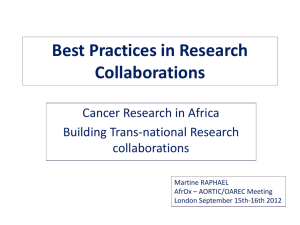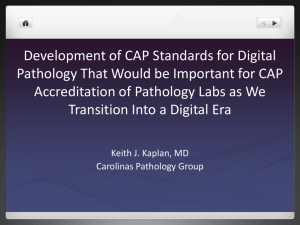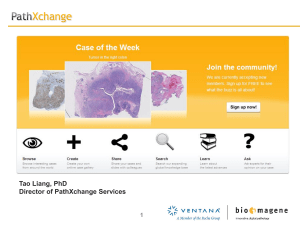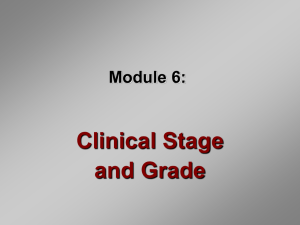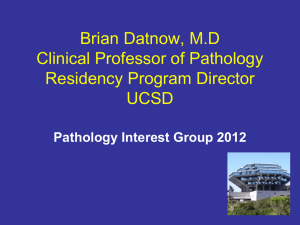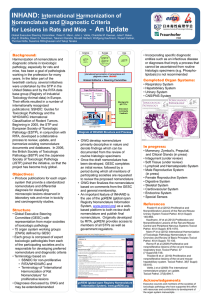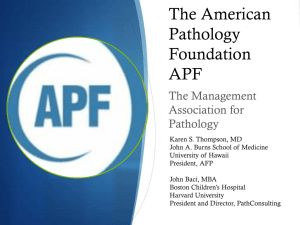New Employee Orientation
advertisement
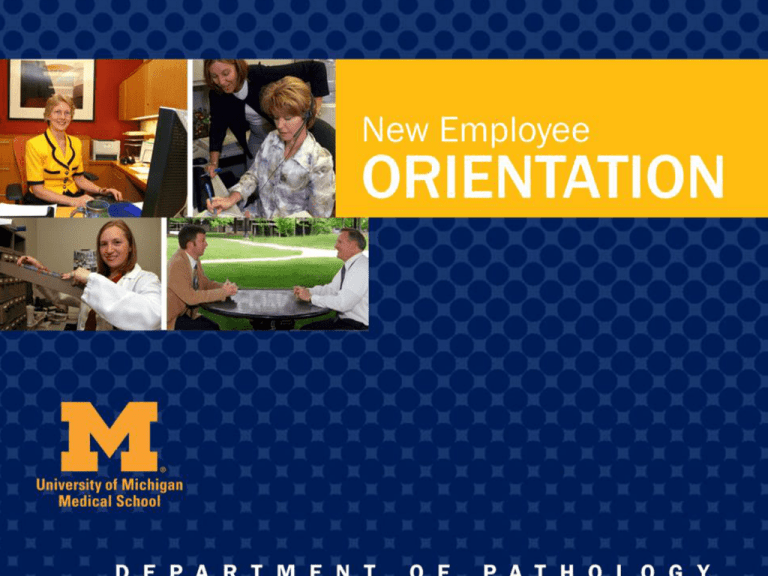
Agenda • • • • • • Introductions About Pathology “All Employees” Information Policies & Procedures UMHS Policies & Information Tour Where do I go? Human Resources Medical School Staff and Faculty Laura Blythe Cathy Bearman Human Resources – Clinical Laboratories Beverly Smith See your booklet for address/phone/e-mail information About Pathology! Aldred S. Warthin, M.D. Carl V. Weller, M.D. A. James French, M.D. 1903-1931 1931-1956 1956-1980 Peter A. Ward, M.D., Jay L. Hess, M.D., Ph.D 1980-2005 2005-present The “pathology” role was filled by an internist or surgeon until 1887. In 1887, the medical faculty of the University noted the Science of Pathology as one of the most important branches of medicine with instruction provided as laboratory work. The first recognized professor in Pathology was N.H. Gibbs who taught a class to the 3 rd and 4th year medical students which included 64 hours of lecture, 50 hours of laboratory work and one autopsy. Disagreements with Dean Victor Vaughn resulted in Professor Gibbs position being combined with Internal Medicine, thereby eliminating Dr. Gibbs role. Dr. George Dock , an internist, was assigned the role of internist/pathologist. Dr. Aldred Warthin was assigned as Dr. Dock’s assistant and once he became proficient in the performance of autopsies, was named the University pathologist. He, subsequently, became the first Chair of Pathology in 1903. Pathology Organization Jay Hess, M.D., Ph.D. Professor and Chairman Director, Division of Finance & Administration Martin A. Lawlor V.A. Hospital Laboratories S. Chensue, MD, PhD Anatomic Pathology J. Myers, MD Clinical Pathology J. Warren, MD Education Programs J. Fantone, MD MLabs Program S. Mandell, MD Informatics A. Chinnaiyan, MD, PhD U. Balis, MD Sponsored Programs J. Hess, MD, PhD S. Kunkel, PhD Translational Research K. ElenitobaJohnson, MD Division of Anatomic Pathology Autopsy Cytopathology Immunohistochemistry Surgical Pathology Diagnostic Services: Breast, Bone, Cardiac, Dermatopathology, Electron Microscopy, Endocrine, Gastrointestinal, Genitourinary, Gynecologic, Head & Neck, Neuropathology, Opthalmic, Pediatric, Pulmonary, Renal and Soft Tissue Division of Clinical Pathology Blood Bank & Transfusion Services Chemical Pathology Cytogenetics Hematopathology Histocompatibility (Tissue Typing) Microbiology & Virology Molecular Diagnostics Point-of-Care Specimen Processing (Central Distribution) Specimen Procurement Division of Education Programs Residency Training Fellowship Training Pathology Graduate Program MLabs Program MLabs is the Department of Pathology's Reference Laboratory Program. Our goal is to bring together state-of-the-art technology and highly trained personnel, including nationally recognized faculty to provide comprehensive, high quality laboratory testing and personalized service to physicians, community hospitals, independent laboratories and managed care organizations. Division of Informatics Clinical Informatics Pathology Informaatics: With a staff of nearly thirty, the PDS group is a technically comprehensive information technology division with full in-house development and implementation capability. Having more that 25 years of operational experience with developing and extending Laboratory Information Systems, the group has been an integral participant in the evolution of laboratory information technology deployment within clinical pathology, and continues to exert this experience in the next-generation systems currently under development. Pathology Imaging (Photography): This unit is a full-service photography laboratory. Service include, but are not limited to, passport photos, event photography, scanning, figure preparation for grants and publications, clinical specimen and research photography. Division of Informatics Research Informatics This division is focused upon the use of information technology to assist in the discovery of new markers of disease and in the identification of prognostic tools to assist with better diagnosis of disease and prediction of therapeutic response and final outcome. Tools produced in this division, such as Oncomine, have already distinguished themselves as of merit to the general oncology community. The division is currently in a major phase of expansion, with the anticipated addition of a comprehensive Mass Spectroscopy computational core facility. Division of Sponsored Programs The Research Programs of the Department of Pathology represent one of the many strengths of our academic mission. Our research faculty successfully compete for extramural research support, attract outstanding graduate students and fellows from both the national and international scene, publish in highly visible, peer-reviewed scientific journals, and serve on numerous national and international scientific committees. Our faculty hold over 86 active grants, 2 program projects, 2 training grants and 2 merit awards. Division of Translational Research The Division of Translational Research includes tissue banking and analytic technologies, such as proteomics. This Division is highly interactive with the divisions of Anatomic Pathology, Clinical Pathology and Sponsored Programs. Division of Finance and Administration Oversight of operations and support staff for: Clinical Pathology Finance and Operations Anatomic Pathology Finance and Operations MLabs Program Human Resources Research (Grant and Contract) Administration Education Office Faculty and Staff 900+ 50+ Research Fellows 36+ House Officers and Clinical Fellows 110+ faculty 600+ staff in the Clinical Laboratories 150+ Medical School and research staff Mission Statement • Education – Excellence in teaching is promoted as an integral part of clinical service; education is what all of our staff do every day. • Research – By encouraging research programs, we also foster a research mentality among all faculty and trainees, with the objective that they acquire useful habits of analytical thought, became more innovative, and become more likely to devise and to employ state of the art diagnostic developments. • Service – Clinical service, largely diagnostic in nature, is a function that sets the Pathology Department apart from other basic science departments. • Unifying Role - Because pathology, more than any other discipline, bridges the domains of basic and clinical science, the Department takes advantage of its unique position to encourage interdisciplinary projects and interdepartmental cooperation. “All Employees” Information! Probation Period: All employees serve a 6 month probationary period. Evaluations are conducted on employees at the end of their initial 6 months of employment. Annual evaluations are conducted on all staff. Time Off (Sick and/or Vacation): PTO: Hospital paid staff participate in the “paid time off” program: Accruals: 13.33 or 17.33 hours per month depending on classification (Pro-rated to appointment) Used for both vacation and sick Can accumulate up to 1 ½ years accrual Medical School Staff: have a vacation accrual and a “sick time” bank. 8 or 16 hours of vacation depending on classification pro-rated to| appointment 120 hours of sick pro-rated to appointment Can accumulate up to 2 years accrual Tuition Reimbursement Program: Must be in a 50% appointment or more Must be employed for 6 months minimum Must complete course with C or better for undergrad – B for grad UM Courses – 75% of cost of in-state tuition for up to 4 credit hours per term. Part time – pro-rated Non UM Courses – 75% of instate tuition or $1352 per term Can receive either an advance OR reimbursement. Must submit paperwork (proof of course costs – advance; bill and grades for reimbursement) More information at: http://spg.umich.edu/pdf/201.69-0.pdf Family Medical Leave Act: After one year – 12 weeks of time off per year during which you can continue medical and life insurance Can be used for personal medical leave, child care leave, or leave to care for an ill family member Renews every year on anniversary date Can be a combination of paid and not paid Right to Know: All employees are protected by the “Right to Know” law. This law ensures that staff know all the details about any and all chemicals with which they work. Laboratories must have a chemical hygiene plan. The plan includes: MSDS(Material Safety Data Sheets) Exposure rating Clean up procedure Inventory of Chemicals Barriers and Workplace Safety: Lab coats used as a primary barrier, gloves and other protective equipment are NEVER to be worn outside of the lab area into clean zones. You never want to contaminate elevators, copy machines, staff lounges, public phones, drinking fountains, etc. Emergency showers and eyewashes are available in the laboratory areas Critical Incidents (YELLOW CARDS): A critical incident is a violent occurrence in the work place. Each hospital laboratory has a procedure to provide guidance to staff members should this type of incident occur. If you feel you are in a potentially threatening situation, remember to ask a co-worker “to get you a yellow card.” That will be their clue to get immediate assistance. Yellow Card Continuing Education: •Human Resources offers opportunities for continuing education. •ITD offers opportunities for continuing education for computers, software/programs. •Pathology web site contains information on continuing education within the department: https://www.pathology.med.umich.edu/ce/ Work Connections: •When an employee is injured on the job, a Work Connections form must be completed. •Work Connections is also notified when an employee is off for more than 10 days, and will assist the employee with a successful return to work! Making a Difference! The Health System’s Making a Difference program recognizes staff who exhibit excellent customer service: •Anyone can be a nominator! •Recognize someone who has done something nice for you! •Who has taken the extra step! Coffee Drinkers: If you drink departmental coffee – you are responsible for paying $2.50 per month!!! Telephones: Each area has their own policy concerning telephone usage. Personal long distance calls must be reimbursed. Computers: •Hospital staff receive their unique name and passwords at Michigan Traditions and Values •Medical School Staff receive their unique name and passwords from the Medical School Human Resources •It is each staff member’s responsibility to read their e-mail daily! Computers are to be used for work during work time – many areas allow web surfing during breaks/lunch •Pathology web site is www.pathology.med.umich.edu Disasters: •Each laboratory has a procedure for staff guidance if the UMHS is called upon to participate in a disaster response. This could be a local tornado, train wreck, airplane crash, chemical disaster, nuclear exposure, etc. Fires: •Fire extinguishers, fire blankets, pull alarms and exit maps are in all lab areas. Staff should use fire extinguishers ONLY when they feel the fire is small enough to control •Know 2 exits from your area! Laboratory or Unit Policies: Lockers: •Provided to new staff located in UH buildings •Locks should not be replaced with personal locks •Locker combinations should not be give to other staff Dress Code: •Present a professional image! •Hair must be neat and groomed! •Practice acceptable standards of personal hygiene and grooming! •Watch those perfumes and colognes! •BLUE denim cannot be worn by Hospital laboratory staff! •No sun dresses, mini skirts or halter tops! No shorts in the Hospital laboratories! •No open toed shoes! •Scrub suits, scrub jackets & lab coats may be worn! Health System Policies, Procedures and Information Health System Wide Announcements: •Fire alarms will sound in all buildings. The UH will announce the location of the fire. •All other emergency codes will be announced over the UH public announcement system. There are specific codes for severe weather, bomb threats and disaster. •The definition of the codes is part of the safety training for all hospital personnel. Compliance Program: It is the policy of the UMHHC to conduct its affairs in accordance with both the letter and spirit of applicable laws and regulations and to share those guidelines with employees and third party affiliates who perform UMHHC medical, research, business and legal activities. Promote an ethical workplace: •Ensure the UMHHC maintains standards in medical, research & legal practices. •Prevent, detect and report civil/criminal conduct concerning fraud & abuse violations. •Educate UMHHC employees & third party affiliates concerning their role. •Provide a workplace that enables employees to participate in compliance without fear of retribution Employee Rights and Responsibilities: •The Corporate Compliance Officer or his/her affiliate should be contacted with any questions. •No representative of UMHS will engage in any activity intended to defraud anyone of money, property or services. •UMHS employees will strive to maintain confidentiality of patient or other information. •UMHS employees owe a fiduciary duty of loyalty from using information gained from their positions to make a profit. •UMHS employees shall conduct all business transactions free from offers or solicitation of gifts and favors. •UMHS employees will strive to preserve and protect the assets of the organization. •UMHS employees will promptly notify the Corporate Compliance Officer or other appropriate University representative of any possible violations Valuing Diversity: Diversity is the set of human attributes and experiences that are different from your own and those of the groups to which you belong We value diversity when we: •Are open •Work to understand each other •Consider differences among teams, friends & staff as assets •Respect and value everyone we work with •Find frequent opportunities to share our interests, cultures, values, ideas and experiences


